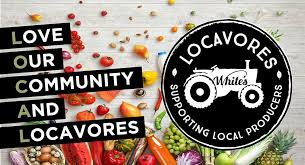Buying local used to be the norm—this woman’s trying to bring it back
By
Maan
- Replies 0
A tiny tractor stamp has been turning heads in supermarkets.
But what looks like a cute design is actually the face of a powerful local food movement.
And one woman’s mission to put paddock-to-plate produce front and centre is gaining serious momentum.
Roz White, the owner of six IGAs across Queensland’s Sunshine Coast, launched the Locavore program to connect shoppers with local producers.
She discovered the term ‘locavore’ on Wikipedia and built a campaign to promote handcrafted, homegrown goods produced within 200 kilometres of her stores.
‘We’ve been practising locavorism for many decades, which basically means we’re just buying local products and produce from a local region,’ she shared.
Each Locavore product now features a tractor emblem in-store—a stamp that reads ‘supporting local producers’ and ‘join the locavores’.
‘That helps our customers to identify local products, where the origins of the fresh food comes from and the story behind it.’
Ms White, who grew up on a farm, said the idea was shaped by her deep appreciation for farming families and the effort behind Australian produce.
‘I grew up on the land. I’m a farm girl, farmer’s daughter, a primary producer’s daughter. I grew up on a farm with cattle and agriculture,’ she said.
‘I just have a great respect for food and where our food comes from. Seeing first-hand the hard work, that goes into producing it and the blood, sweat, and tears, the highs and lows and the droughts and the good times and bad times.’
‘That had a big influence on being able to recognise (local work), bringing it into the store and celebrating the families who create our food that we enjoy.’
Over the past 13 years, her Locavore shelves have helped launch small producers—including multimillion-dollar brands like Coyo Yoghurt.
Her stores currently feature goods from 170 local suppliers, and she has set an ambitious goal to increase that number to 200 by the end of the year.
‘It’s important to a lot of people. There are conscious and mindful shoppers and this is for the conscious and mindful shopper,’ she said.
‘But it’s also about inspiring and igniting interest and engagement of other people that’s sort of bringing them in because people do really care about where their food comes from and people care about our planet.’
From lettuce and mushrooms to pineapples, strawberries, eggs and Mooloolaba prawns, White said the selection is endless—and often surprisingly affordable.
‘There’s so much here to enjoy. It’s particularly the fresh produce, the lettuce, tomatoes, mushrooms, eggs, pineapples, strawberries, avocados, it’s truly endless,’ she said.
‘I can walk in and I go, “yep, that’s local, local, local”. I don’t even need a sign because I know where it all comes from.’
‘Don’t be hoodwinked into thinking that you can just walk into a store and get a product that’s cheap just because that’s what they’re known for.’
‘Think about the taste, think about the quality and freshness of that product that’s going to last longer in your fridge and think about the enjoyment of being able to nourish your family and nourish another family at the same time when you’re having that.’
If this story made you think twice about where your groceries come from, you’re not alone.
Local producers play a crucial role in our food chain—but many are doing it tough behind the scenes.
For a closer look at the challenges they’re facing and how your shop can make a difference, here’s another story worth reading.
Read more: Farmers hit by drought and floods call on Australians to shop local and lend a hand

Would you be more likely to buy a product if you knew the farmer behind it?
But what looks like a cute design is actually the face of a powerful local food movement.
And one woman’s mission to put paddock-to-plate produce front and centre is gaining serious momentum.
Roz White, the owner of six IGAs across Queensland’s Sunshine Coast, launched the Locavore program to connect shoppers with local producers.
She discovered the term ‘locavore’ on Wikipedia and built a campaign to promote handcrafted, homegrown goods produced within 200 kilometres of her stores.
‘We’ve been practising locavorism for many decades, which basically means we’re just buying local products and produce from a local region,’ she shared.
Each Locavore product now features a tractor emblem in-store—a stamp that reads ‘supporting local producers’ and ‘join the locavores’.
‘That helps our customers to identify local products, where the origins of the fresh food comes from and the story behind it.’
Ms White, who grew up on a farm, said the idea was shaped by her deep appreciation for farming families and the effort behind Australian produce.
‘I grew up on the land. I’m a farm girl, farmer’s daughter, a primary producer’s daughter. I grew up on a farm with cattle and agriculture,’ she said.
‘I just have a great respect for food and where our food comes from. Seeing first-hand the hard work, that goes into producing it and the blood, sweat, and tears, the highs and lows and the droughts and the good times and bad times.’
‘That had a big influence on being able to recognise (local work), bringing it into the store and celebrating the families who create our food that we enjoy.’
Over the past 13 years, her Locavore shelves have helped launch small producers—including multimillion-dollar brands like Coyo Yoghurt.
Her stores currently feature goods from 170 local suppliers, and she has set an ambitious goal to increase that number to 200 by the end of the year.
‘It’s important to a lot of people. There are conscious and mindful shoppers and this is for the conscious and mindful shopper,’ she said.
‘But it’s also about inspiring and igniting interest and engagement of other people that’s sort of bringing them in because people do really care about where their food comes from and people care about our planet.’
From lettuce and mushrooms to pineapples, strawberries, eggs and Mooloolaba prawns, White said the selection is endless—and often surprisingly affordable.
‘There’s so much here to enjoy. It’s particularly the fresh produce, the lettuce, tomatoes, mushrooms, eggs, pineapples, strawberries, avocados, it’s truly endless,’ she said.
‘I can walk in and I go, “yep, that’s local, local, local”. I don’t even need a sign because I know where it all comes from.’
‘Don’t be hoodwinked into thinking that you can just walk into a store and get a product that’s cheap just because that’s what they’re known for.’
‘Think about the taste, think about the quality and freshness of that product that’s going to last longer in your fridge and think about the enjoyment of being able to nourish your family and nourish another family at the same time when you’re having that.’
If this story made you think twice about where your groceries come from, you’re not alone.
Local producers play a crucial role in our food chain—but many are doing it tough behind the scenes.
For a closer look at the challenges they’re facing and how your shop can make a difference, here’s another story worth reading.
Read more: Farmers hit by drought and floods call on Australians to shop local and lend a hand
Key Takeaways
- The Locavore program highlights locally sourced products within 200km of stores.
- Products are marked with a tractor emblem to help shoppers identify local options.
- Roz White aims to support 200 local producers by year’s end.
- Well-known brands like Coyo Yoghurt got their start through the initiative.
Would you be more likely to buy a product if you knew the farmer behind it?








